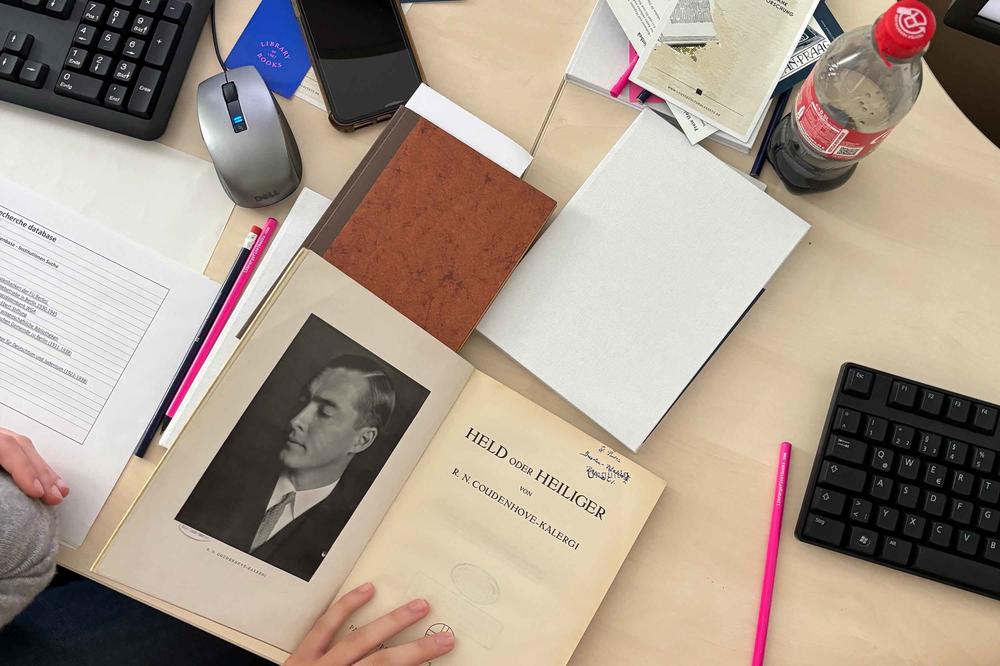Culture of Remembrance: The Trail of Books
The library of the Higher Institute for Jewish Studies, a rabbinical seminary in Berlin from 1872 to 1942, contained 60,000 volumes. One that disappeared during the Nazi era remained unnoticed in the stacks of Freie Universität’s University Library.
Dec 12, 2024
The Provenance Research Unit hosted an action day for high school students.
Image Credit: Freie Universität Berlin
Sometimes books tell a story beyond the content in their pages. An example of this is a book published by Simon Bernfeld in 1921, entitled Jüdische Literatur (Jewish Literature). Ringo Narewski, Elena Brasiler, Marcus Dost, and Susanne Paul from the Provenance Research Unit were electrified when they unexpectedly discovered the book in their holdings. Bernfeld (1860–1940) was a rabbi, scholar, and writer.
The Provenance Research Unit at Freie Universität Berlin’s University Library conducts research on the history of books in Freie Universität’s holdings whose exact origins are unknown. They are especially interested in books that had previously been owned by Jews who were murdered by the Nazis or scattered throughout the world in search of asylum.
After lengthy research it became clear that this particular book had once belonged to the library of the esteemed Higher Institute for Jewish Studies (Hochschule für die Wissenschaft des Judentums). Franz Kafka himself spent many hours in this library in Berlin during the last months of his life in 1924. Kafka’s works contain many motifs from Jewish traditions, and he also reflects on his own Jewishness in some of his works.
Book Passed through Theresienstadt Concentration Camp
The Higher Institute for Jewish Studies was located on present-day Tucholsky Strasse in the Berlin's Mitte district. The Nazis closed it down in 1942 and confiscated the 60,000 books from its library. Ringo Narewski, who heads the Provenance Research Unit, notes, “A conspicuous red stamp at the front of the book alerted us to the fact that after 1942 it was part of the holdings of the ghetto library at the Theresienstadt concentration camp. It reached us through the library of the Institute for Protestant Theology at Freie Universität, which had incorporated it into its holdings in 1976. After the theology institute was closed in 2009, it was added to the Campus Library.”
It is still not clear how the book found its way to Freie Universität after the Theresienstadt concentration camp was liberated in 1945. Narewski and his team exchanged information with, among others, colleagues in Prague, who had succeeded in transferring many thousands of books from the Higher Institute for Jewish Studies to the Jewish Museum. However, Narewski points out that there are hardly any living witnesses left who were able to help reconstruct how the book reached Freie Universität. He says, “That’s why we absolutely need the collective intelligence of a good network.”
This is a perfect example of how the Leo Baeck Institute in Jerusalem with its research project “The Library of Lost Books” can help. All of the holdings from the former Higher Institute for Jewish Studies that turn up are inventoried in a globally accessible database and made available online as a digital copy. The highly regarded institute in Jerusalem bears the name of the rabbi Leo Baeck, one of the most important representatives of liberal German Judaism. Baeck, in turn, once taught at the Higher Institute for Jewish Studies.
Red Stamp from the Ghetto
The book found at Freie Universität is now part of the Library of Lost Books. Ringo Narewski and his colleagues provided the experts in Jerusalem with all the information and details about the volume. The book itself remains at Freie Universität. It is the second book since 2019 that was able to be attributed to the Higher Institute for Jewish Studies.
“We could hardly believe that this book had simply been standing on a shelf in the main library, available to be borrowed by library users at any time,” says Elena Brasiler when describing her astonishment that apparently no one in the library had noticed the red stamp from the ghetto library. Or if they had noticed, it apparently did not occur to anyone to start investigating the matter. In addition, the book clearly bears a round stamp from the library of the Higher Institute for Jewish Studies along with a notation in pencil of the copy number.
“Forty or fifty years ago the provenance of newly acquired books did not play as important a role as it does today,” says Brasiler. “Becoming aware of the issue of stolen cultural assets and the significance of provenance research is a relatively recent development.”
Brasiler stresses that provenance research is “a fascinating mixture of research, detective work, and puzzle solving.” She would like to convey all of that, along with the story of the discovery of this volume, to the younger generation. To this end, during the past summer, the team invited high school students from the Arndt Gymnasium in Berlin's Dahlem distric to an action day revolving around the Library of Lost Books project. After a short introduction to the history of the Higher Institute for Jewish Studies as well as an introduction to the online library catalog Primo and the targeted search for books, the team gave the young people individual research assignments.
“The students quickly realized that looking for stolen books is not an easy task,” says Brasiler. “It is not sufficient to look for titles and authors; the history of the books as well as the times and places they were created have to be taken into account.”
That requires a certain amount of background knowledge as well as an interest in the darker chapters of German history. Brasiler notes that the students exhibited a great deal of interest in the subject. She says, “We had expected about fifteen participants, but thirty showed up, and everyone was enthusiastic.”
This article originally appeared in German in the Tagesspiegel newspaper supplement published by Freie Universität Berlin.

